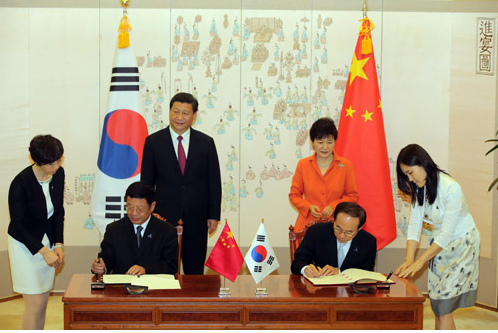
The Korea-China Summit Meeting Opens an Era of Partnership of the Two Countries forthe Win-Win Environmental Cooperation

□ Signing of the “MOU on Environmental Cooperation between Korea and China” and the “MOU between Korea and China on Cooperation to Preserve Wildlife and Natural Ecosystem” Implementation of cooperative projects regarding sharing of atmospheric pollution measurement data, operation of the joint research group, substantial efforts to prevent atmospheric pollution, preventive monitoring of avian influenza, and preservation of endangered species of wildlife
□ Establishment of comprehensive Korean-Chinese cooperation encompassing all available environmental technologies as the two countries belong to the same environmental community and ecological system The Ministry of Environment (Minister Yoon Seong-kyu) said on July 3, 2014 that it signed the “MOU on Environmental Cooperation between Korea and China” with the Ministry of Environmental Protection of China, and the “MOU between Korea and China on Cooperation to Preserve Wildlife and Natural Ecosystem” with the State Forestry Administration of China.
* State Forestry Administration: the Chinese government agency responsible for the preservation of wildlife and natural environment
The Memoranda of Understanding were signed with the presence of the summits of the two countries who met to promptly resolve the problems of atmospheric pollution caused by the interplay of aerosol dust (PM10) of the two countries and avian influenza caused by migratory birds.
As such, Korea will be able to foresee the occurrence of high-density aerosol dust in China one or two days earlier than the present. This is expected to remarkably promote the accuracy of forecast of aerosol dust. In addition, the two countries agreed that a Korean-Chinese Joint Research Group would be formed within the year to develop models of atmospheric pollution forecasting and research on the causes of generating atmospheric pollution.From 2015 on, the two countries will promote each other’s expertise and mutual understanding by exchanging their science and technology personnel of atmosphere.The Memoranda of Understanding designated the responsible agencies of the two countries to continually review the process and performance of the cooperative projects.* Responsible agencies: National Institute of Environmental Research of Korea ↔ the China National Environmental Monitoring Center and the Chinese Research Academy of Environmental Sciences
The MOU on Environmental Cooperation between Korea and China also aims to promote industrial cooperation in environment with China. The Chinese government implements a large-scale investment, which is worth 435 trillion won or about 435 billion dollars to be spent for two years from 2014, to resolve environmental problems including aerosol dust. In particular, 304 trillion won or about 304 billion dollars will be spent only for reducing aerosol dust. As the environment market is growing very rapidly, the need for environmental cooperation between Korea and China is also increasing.According to the MOU, substantial efforts to prevent atmospheric pollution will be jointly made to apply Korean technologies of dust collection, denitrification, and desulfurization to steel mills in China.
In addition, foundation was also established to expand two countries’ environmental cooperation focusing on major sources of atmospheric pollution including thermal power plants.Korea and Shandong Province of China agreed on June 10, 2014 that they would jointly conduct a demonstrational project of building atmospheric pollution prevention facilities for dust collection, denitrification, etc. of thermal power plants. Cooperative projects based on the two countries’ MOUs are expected to reduce atmospheric pollutants such as smog and aerosol dust. It is further expected that advance of the Korean environmental industry with advanced environmental technologies of water and waste treatment into China will be promoted. The MOU between Korea and China on Cooperation to Preserve Wildlife and Natural Ecosystem defines monitoring of wildlife diseases including avian influenza, research on the restoration of ecosystem in desertified areas, preservation of endangered wildlife, management of preservation areas, sharing of and joint research cooperation in management policy of export-and-import of wildlife. This cooperation is an expansion to wildlife and natural ecological system from the success of the Korean-Chinese Cooperation Project to Protect Crested Ibises of the last year.
* Korean-Chinese Cooperation Project to Protect Crested Ibises: A project to restore and breed crested ibises by importing them from China in 2008 and 2013.
Korea and China have recently strengthened their cooperation efforts to promote sharing of information on the outbreak of avian influenza and on observing the traveling routes of migratory birds. The singing of the MOUs is expected to facilitate and fortify these cooperation efforts.
* The two countries shared the observation data of migratory birds and the information on the occurrences of avian influenza to prevent the outbreak of avian influenza when the avian influenza virus was found in the migratory birds traveling over the two countries early this year.
The Ministry of Environment expects that cooperation with China will benefit Korea in the restoration of wildlife and prevention of avian influenza as China, a very large country with abundant natural and ecological resources, has advanced policies and rich experience in preservation of nature.Yoon Seong-kyu, Minister of Environment said, “The Korean-Chinese environmental MOUs and ensuing cooperative projects will greatly help resolve the environmental issues, such as aerosol dust, pending between the two countries.”